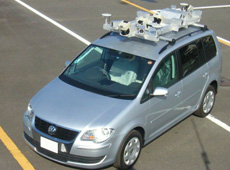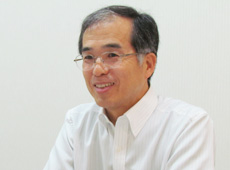Q. Were you satisfied with the results of your experiment?
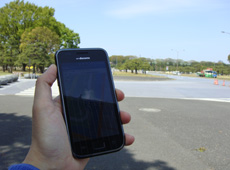
Reception of position signals improves near the Imperial Palace, where there are no tall buildings. (courtesy: Hideo Makino.)
MICHIBIKI was launched in September 2010, and I began this experiment in April 2011. At the time the receiver’s performance still wasn’t stable, and it couldn’t receive position signals between buildings in Ginza very well, so the readings were off by about 10 meters. The problem is that navigation software assumes you are moving in the middle of the road. For example, when I’m walking on the sidewalk on the north side of Harumi-dori Avenue, it tells me to "move 3 meters to the south." And at times it thought I was walking on the south side, even though I was walking on the north side of the street. Harumi-dori is a wide avenue with three lanes of traffic in each direction, so this sort of mistake is a problem.
On the other hand, when I walk from Ginza to the Imperial Palace, reception improves, because there are no buildings nearby. There, positioning can be accurate to within a few meters. Places near tall buildings have room for improvement, but in places with good views, such as parks, I felt I could get accurate guidance.
Q. What issues did the experiment reveal?
First is the need to improve positioning accuracy. I think that visually impaired people need location information that’s accurate down to one meter, which will allow them to distinguish between sidewalks and roads. Another thing is that using current map information, all they get is the information on the map - for example, "This is the Imperial Palace," or "This is City Hall." This isn’t enough for a blind person. They need more detailed information: "You have crossed the moat of the Imperial Palace," or "This is the entrance to City Hall." Then we can equip mobile phones with a feature that allows the user to enter additional information to confirm they’re in the right place.
In addition, as you know, MICHIBIKI orbits over Japan for only eight hours a day. It’s the only satellite in the system right now, so for the time being the system is useable for eight hours a day. And unless MICHIBIKI can be used 24 hours a day, it will not be user-friendly for the visually impaired. Getting a message that says "Road guidance not available at this time" is inconvenient. So I would really like to see the second and third satellites launch soon.
Q. What made you think of creating a navigation system for the visually impaired?
About 20 years ago, I visited a facility for the handicapped in Canada. I saw a TV with a feature that allowed it to display closed-captioned subtitles, and I learned it was Japanese technology. At the time there was a law in the United States requiring new TVs to have this closed-captioning feature. But that technology had not spread in Japan because it was not required by law. A Canadian said to me, "How can it be that people with disabilities in Japan don’t have this Japanese technology, when it’s so widely used here?" I was ashamed. I began to feel that Japan must become a society that is kind to people with disabilities.
Later, I met a teacher at a school for the blind people in Niigata, and I asked what some of the students’ typical problems are. This teacher said to me, "They want to walk outside more, but when they walk outside, the studded paving block they rely on can’t be found everywhere. And in Niigata, where it snows a lot, they can’t use studded paving blocks in winter because they get covered up by snow." So I decided I wanted to create a system that can provide audio location information anywhere, in any weather. I participated in demonstration testing for MICHIBIKI because I have a strong desire to improve road guidance accuracy for the visually impaired.
Q. How do you think life will change for people with disabilities when the Quasi-Zenith Satellites become available for practical applications?
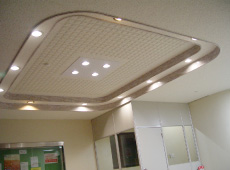
An indoor guidance system that uses light fixtures. (courtesy: Hideo Makino.)
I want to create an environment in which the visually impaired can safely walk anywhere, anytime, 24 hours a day. This is why I am also working on a system to provide audio location guidance through light fixtures. This feature would allow people to know exactly where they are at all times, even indoors or underground. There’s a circuit inside light fixtures that controls the brightness of the light. That circuit can also be used to provide audio location guidance. So all you have to do is change the fixture and install one that that emits a locator signal. There’s no need to change the whole lighting system. That eliminates the trouble and cost involved in installing new equipment. My goal is to use Quasi-Zenith Satellites outdoors, and another technology indoors to provide the visually impaired with location information wherever they are.
Furthermore, location information shouldn’t just tell us our location. I think it also needs to warn us about obstacles and other objects. A small bump in the road doesn’t worry a person with normal vision, but it can cause serious injury to a blind person. I would like to use MICHIBIKI’s high accuracy to provide warning information to the visually impaired.
Q. What do you think needs to happen first to make MICHIBIKI ready for practical application?
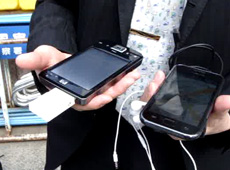
The Quasi-Zenith Satellite receiver (left) and guidance device (right) used for demonstration testing of a handheld navigation system. (courtesy: Yasushi Iwashita.)
MICHIBIKI receivers need further improvements, and smartphones with built-in receivers need to become widely available. Once that happens, more people, not just the visually impaired, can take advantage of MICHIBIKI’s capabilities. I think that if we build a system of multiple Quasi-Zenith Satellites, the receiver market will expand, and improvements will come quickly. In Japan we’ve long been working with GPS receivers, such as automobile navigation systems, so I expect that we could tweak their internal software to make them compatible with MICHIBIKI. If the receivers were available at no cost, then I think people would quickly start using MICHIBIKI in more practical ways. So of course, the most important thing is to bring it into general use.
Earlier I talked about indoor guidance systems that use light fixtures. While my end goal is to develop technology for the visually impaired, I am also working on systems that would appeal to people with normal vision, too. There are two reasons for this: the market for products aimed only at people with disabilities is small, and even if you invest a lot in development they still may never make a profit. If you can’t mass-produce a product, then the price becomes high. If it’s not affordable, it won’t sell, and I think improvements will only be made if there are sales to support the product. This is why I think it is important, when creating services for people with disabilities, to develop "common items" that both the disabled and non-disabled can use from the outset, and to create an environment in which the product can spread quickly once it’s released.
Professor, Department of Information Engineering, Faculty of Engineering, Niigata University
Prof. Makino graduated from the Department of Electronic Engineering at the Faculty of Engineering, Niigata University in 1976. He earned his Master’s degree from Niigata University Graduate School in 1978, and began working at the university’s Department of Information Engineering the same year. He became an associate professor in 1990 and a full professor in 1995. In 1996, he was involved in research on correcting GPS positioning accuracy at the University of California, Santa Barbara. Recently he has been conducting technical research on subjects such as lighting communication and geographical information systems. Prof. Makino’s areas of expertise include the development of medical devices, information processing systems, information devices, etc.
Automating the Japanese Farm
A Safer World for the Visually Impaired
Seamless Indoor/Outdoor Positioning, Developed in Japan
Building a Better Satellite-Based Positioning System


